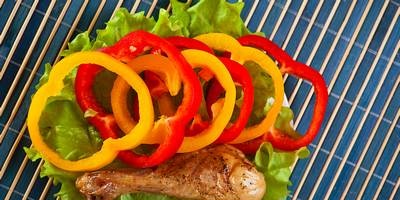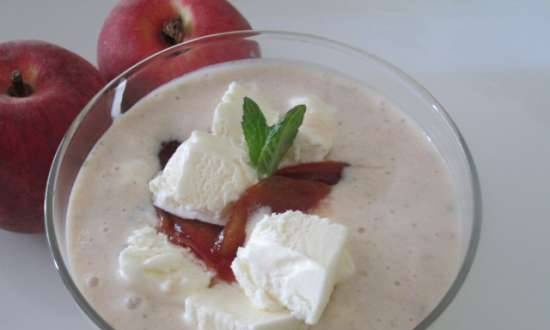|
 Thanks to the use of various methods of culinary processing, it is possible to preserve the components of food products to a significant extent. Thanks to the use of various methods of culinary processing, it is possible to preserve the components of food products to a significant extent.
When food is cooked in water, taken in such an amount that the product is completely immersed in it, most of the water-soluble nutrients pass into the broth, which is most often not used and poured out. As a result, valuable nutrients are lost. Therefore, this method of culinary processing can only be used for those food products that are capable of swelling strongly (legumes, grain products, pasta).
When boiling a product in water, its boiling point ranges from 75-100 ° C. This is the temperature of protein coagulation and starch gelatinization. The liquid must be taken in a minimum amount. It is recommended not to pour it out, but to use it for making sauces, salad dressings or marinades.
Bringing the product to readiness in water must be carried out after a short boil.
Steam treatment - this is bringing a food product to readiness in a well-closing vessel in an atmosphere of water vapor. The amount of liquid required for this is negligible and the product is separated from the liquid by a sieve insert on which it is placed.
Extinguishing - this is bringing the product to readiness in a small volume of light liquid. A mixture of small amounts of fat and liquid is brought to a boil (100 ° C), after which the product is added to the mixture. When stewing, the color of the product must not change. Sealing the vessel prevents the liquid from evaporating. As a result of this heat treatment, only a small amount of nutrients are leached. The small amount of liquid left over from the stew can be used for other culinary purposes.
The stewed food products are particularly good in quality and taste.
The time for stewing fish, depending on the size and thickness of the pieces, is 15-25 minutes; for meat it depends on the species and age of the animals. Stew vegetables about the same as fish.
Frying - this is bringing the product to readiness by heating it with fat or vegetable oil without adding liquid. For frying, take thin, even pieces of meat or fish, which quickly form a crust. At the same time, frying products are formed, which change the color and taste of the product. Large pieces of meat are braised after roasting. In this case, the meat is brought to readiness by repeatedly adding a small amount of liquid as it evaporates. The result of this process is a delicious sauce.
 Baking in a fat bath - This is deep-fat frying, at which the temperature is 160-180 ° C. Due to the high temperature, the cooking process is significantly reduced. The product should float in fat. Suitable fat is vegetable oil, solid vegetable fat or rendered pork fat (lard). If the temperature of the fat bath is too low, the product absorbs too much fat and remains colorless. It turns out to be difficult to digest and falls apart. If the temperature is too high, crusting and browning will occur before the ready state is reached. The cooking process at the correct temperature can be considered complete if the food (fish pieces, meat in dough, breaded vegetables, potato sticks and so on), first immersed in fat, floats to the surface. Baking in a fat bath - This is deep-fat frying, at which the temperature is 160-180 ° C. Due to the high temperature, the cooking process is significantly reduced. The product should float in fat. Suitable fat is vegetable oil, solid vegetable fat or rendered pork fat (lard). If the temperature of the fat bath is too low, the product absorbs too much fat and remains colorless. It turns out to be difficult to digest and falls apart. If the temperature is too high, crusting and browning will occur before the ready state is reached. The cooking process at the correct temperature can be considered complete if the food (fish pieces, meat in dough, breaded vegetables, potato sticks and so on), first immersed in fat, floats to the surface.
Baking - this is bringing the product to readiness with hot air, achieved as a result of direct exposure to the high temperature of an open flame (frying oven or brazier). This way you can cook whole, not too thick fish (for example, pike or pike perch), tender meat in pieces (fillets) or slices (fillet slices) or sausages. It is important to maintain a high temperature at the level of 250-350 ° C. The heat treatment is short-lived, food substances are well preserved, and products (meat or fish) acquire a special pleasant taste. To avoid drying out, pieces of fish or meat are greased or covered with wax paper. During the baking process, make sure that as little juice as possible flows out. This is why it is important to achieve a fast, thin crust. Inside the finished product, a temperature is reached at which the protein coagulates (160-70 ° C), the tissue fluid expands, as a result of which the tissue turns into a fibrous mass and looses, which is especially appreciated in fried dishes. Too long baking will reduce the nutritional value and taste of the food.
The above quantitative yields were established on the basis of numerous experiments carried out in salad kitchens, and are average values. Of course, there may be deviations in one direction or another, since the raw materials intended for processing are not always of the same quality. These deviations are minor and do not affect the calculation.
It is necessary to detect surplus finished products in a timely manner. Output quantities form the basis for the preparation of salads and other products and are in accordance with the quantities indicated in the recipes.
Additional instructions for preparing salads
Salads are prepared from perishable foodstuffs, which is why it is necessary to follow the rules for their use and storage.
Salads should not be exposed to sunlight, strong heating or deep refrigeration. The most favorable conditions for storage are created at a temperature of 4-8 ° C and a relative humidity of 70-80%. Under these conditions, salads can be stored for up to 2 days. At a higher or lower temperature, the components of the mayonnaise - butter and eggs - are separated, and the salad becomes unattractive. At elevated temperatures, fermentation occurs under the influence of bacteria. The salad in this case is no longer suitable for consumption.
In enterprises, salads must be prepared for sale only in plastic, porcelain or faience dishes, which are covered with a transparent lid.
Salads cannot be stored in metal containers! Due to the presence of organic acids in salads, the oxidation of metals occurs, the resulting oxides can cause poisoning. For the same reasons, it is recommended to take salads with plastic spoons or horny ones.
Only the amount of lettuce that is sold in the next few hours is taken from the preparation vessel, which must always be closed.
Leftover lettuce that has not been sold must not be returned to the supply vessel, where it could cause decomposition of the lettuce remaining in it.
O. E. Linke, R. Hennig, "Salads and Savory Spices"
|
 Thanks to the use of various methods of culinary processing, it is possible to preserve the components of food products to a significant extent.
Thanks to the use of various methods of culinary processing, it is possible to preserve the components of food products to a significant extent.






